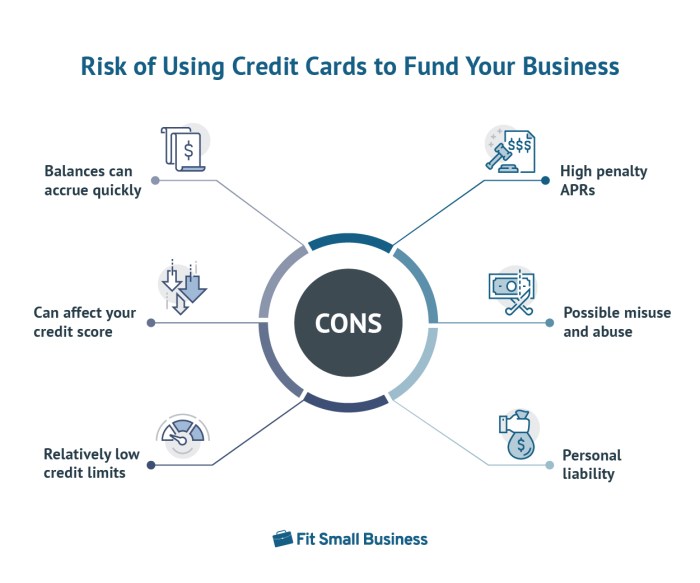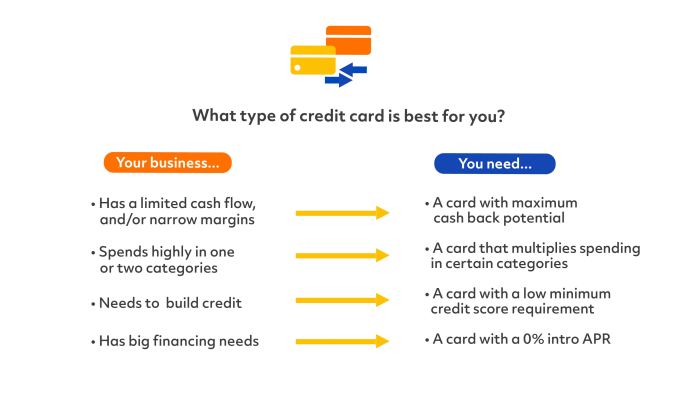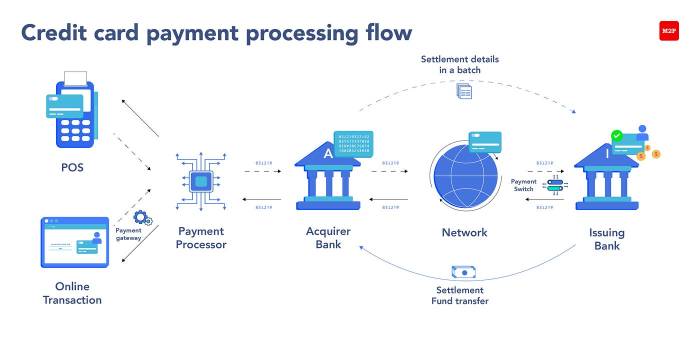Strategies for Managing Credit Card Debt While Growing a Business
Strategies for managing credit card debt while growing a business presents a significant challenge for many entrepreneurs. Balancing the need for business investment with the burden of personal debt requires careful planning and strategic execution. This guide explores practical methods for navigating this complex financial landscape, offering actionable steps to achieve both financial stability and business success.
From understanding your current financial standing and implementing effective debt repayment strategies, to mastering business finance and establishing robust budgeting practices, we will cover essential aspects of managing your finances holistically. We’ll examine various approaches to debt reduction, such as the debt snowball and avalanche methods, and discuss the implications of balance transfers and debt consolidation. Furthermore, we’ll delve into strategies for improving business cash flow, securing alternative funding sources, and creating a long-term financial plan that incorporates both debt repayment and business growth objectives.
Long-Term Financial Planning
Successfully navigating credit card debt while building a business requires a robust long-term financial plan. This plan should integrate debt reduction strategies with your business growth objectives, ensuring a sustainable path to financial health and prosperity. It’s not simply about paying down debt; it’s about creating a financially secure future for both your personal life and your business.A comprehensive long-term financial plan combines several key elements, creating a roadmap for your financial journey.
This involves strategically allocating resources to pay down high-interest debt, while simultaneously investing in your business’s growth and building a safety net for unexpected events. This approach ensures that you’re not just surviving, but thriving, financially.
Building an Emergency Fund
An emergency fund acts as a crucial buffer against unexpected expenses, preventing the need to rely on high-interest credit cards during challenging times. Aim to accumulate 3-6 months’ worth of living expenses in a readily accessible, low-interest savings account. This fund provides a safety net for unforeseen circumstances, such as medical emergencies, job loss, or unexpected business expenses.
For example, a business owner facing a sudden equipment malfunction can use their emergency fund to cover repairs instead of resorting to credit. This prevents further debt accumulation and maintains financial stability.
Incorporating Regular Savings into Your Budget
Regular savings are vital for both personal and business goals. Creating a realistic budget that allocates a specific amount to savings each month is crucial. This could involve setting up automatic transfers from your checking account to a savings account. Consider allocating a percentage of your income to savings, perhaps starting with a smaller percentage and gradually increasing it as your income grows.
For instance, setting aside 10% of your income for personal savings and another 5% for business reinvestment is a reasonable starting point, which can be adjusted based on individual circumstances and financial goals. This consistent savings approach fosters financial discipline and ensures steady progress towards your financial objectives.
Debt Repayment Strategy Integrated with Business Growth
A successful long-term financial plan incorporates a clear debt repayment strategy alongside your business growth objectives. Prioritize high-interest debts, such as credit card debt, while strategically investing in your business’s expansion. This could involve developing a detailed budget that allocates a specific amount each month towards debt repayment, while simultaneously reinvesting profits back into the business. For example, a small business owner might allocate 20% of monthly profits towards credit card debt repayment and 30% towards marketing and expansion.
This balanced approach ensures that you’re making progress on both fronts, building a financially secure future for your business and personal life. Consider exploring debt consolidation options to potentially lower interest rates and simplify repayments.
Seeking Professional Help
Navigating the complexities of managing credit card debt while simultaneously building a business can be overwhelming. Seeking professional guidance can significantly improve your chances of success and alleviate the stress associated with financial strain. Expert advice can provide clarity, structure, and a personalized roadmap tailored to your unique circumstances.A financial advisor or business mentor offers invaluable support by providing objective perspectives, identifying potential blind spots in your financial strategies, and offering tailored solutions.
A financial advisor can help you create a comprehensive budget, develop a debt repayment plan, and explore options for debt consolidation or refinancing. A business mentor, on the other hand, can assist with strategic planning, resource allocation, and overall business growth, ensuring your financial health is supported by a thriving enterprise. Their expertise can prevent costly mistakes and help you make informed decisions to optimize your financial trajectory.
Resources for Small Business Owners Facing Financial Challenges
Numerous resources are available to assist small business owners facing financial hardship. These resources offer support ranging from financial counseling to government-backed loan programs. Accessing these resources can be crucial in mitigating financial risks and securing the future of your business.The Small Business Administration (SBA) provides a wealth of resources, including counseling services, training programs, and loan guarantees.
SCORE, a non-profit organization, offers free mentoring and workshops for small business owners. Local chambers of commerce frequently provide networking opportunities and access to financial resources specific to your region. Furthermore, many non-profit organizations focus on providing financial literacy education and assistance to entrepreneurs facing financial challenges. These organizations often offer workshops, one-on-one counseling, and access to resources that can help you develop a sustainable financial plan.
Negotiating with Creditors
Negotiating with creditors is a crucial step in managing credit card debt. Successfully negotiating lower interest rates or payment amounts can significantly reduce your financial burden and improve your cash flow. A proactive and well-prepared approach is essential to increase your chances of a favorable outcome.The process typically involves contacting each creditor individually and explaining your financial situation honestly and clearly.
Presenting a well-structured proposal, outlining your current financial limitations and a proposed revised payment plan, can greatly enhance your negotiation position. Many creditors are willing to work with borrowers facing genuine financial difficulties, as it is often more beneficial for them to receive reduced payments than to initiate collection procedures. Documenting all communication and agreements with creditors is crucial to avoid future misunderstandings.
If you are unable to reach an agreement independently, consider seeking assistance from a credit counselor or debt negotiator, who can navigate the complexities of the process on your behalf. Remember to carefully review any agreements reached before finalizing them to ensure they align with your financial capabilities and long-term goals.
Visualizing Progress
Visualizing your financial progress is crucial for staying motivated and on track when tackling credit card debt while building a business. Seeing your progress, both in debt reduction and business growth, provides tangible evidence of your hard work and helps maintain momentum during challenging times. This visualization can also highlight areas needing adjustment in your strategies.Creating clear visual representations of your financial goals helps you understand your current situation and anticipate future scenarios.
This proactive approach allows for timely course corrections, maximizing your chances of success.
Debt Repayment Timeline Chart, Strategies for managing credit card debt while growing a business
A bar chart effectively illustrates your projected debt repayment timeline. The horizontal axis represents time, divided into months or years, depending on your repayment plan. The vertical axis represents the outstanding debt balance. Each bar represents a period, with its height corresponding to the remaining debt amount at the end of that period. For example, if you start with $10,000 in debt and aim to pay it off in 12 months, the first bar would be at $10,000.
Subsequent bars would progressively decrease in height as you make payments, eventually reaching zero at the 12-month mark. Different colors can be used to represent different credit cards if you have multiple debts. A line graph could also be overlaid to show the cumulative amount paid over time. This provides a clear, concise view of your progress toward becoming debt-free.
Business Financial Projections Chart
A line graph is ideal for visualizing your business’s financial projections over the next 12 months. The horizontal axis represents the months, and the vertical axis represents revenue and expenses in monetary units (e.g., dollars). Two lines are plotted: one for projected revenue and another for projected expenses. The area between these lines represents your projected profit or loss for each month.
For instance, if you project $5,000 in revenue and $3,000 in expenses in the first month, the revenue line would be at $5,000, the expense line at $3,000, and the area between them represents a $2,000 profit. A third line could represent your cumulative profit over the 12-month period. This visual helps you track your business’s financial health and identify potential challenges or opportunities.
For added clarity, you could add markers to highlight significant events like marketing campaigns or seasonal changes that might impact revenue or expenses. A simple example could be a projected increase in revenue during the holiday season, clearly shown as a peak in the revenue line. This type of chart allows for easy identification of potential cash flow issues and helps in planning for future investments or debt repayments.
Successfully navigating the intersection of credit card debt and business growth requires a multifaceted approach. By diligently implementing the strategies Artikeld in this guide – from meticulously tracking finances and employing effective debt repayment methods to optimizing business cash flow and building a strong emergency fund – entrepreneurs can effectively manage their financial obligations while pursuing their business ambitions. Remember, seeking professional advice when needed can provide invaluable support and guidance on this journey.
Top FAQs: Strategies For Managing Credit Card Debt While Growing A Business
What if I can’t afford my minimum credit card payments?
Contact your credit card company immediately. Explain your situation and explore options like hardship programs or temporary payment reductions. Consider seeking credit counseling for professional assistance.
How can I improve my credit score while paying off debt?
Consistent on-time payments are crucial. Keep credit utilization low (ideally under 30% of your total credit limit). Avoid opening new credit accounts unless absolutely necessary. Monitor your credit report regularly for errors.
What are the tax implications of using personal credit cards for business expenses?
Keep meticulous records of all business expenses paid with personal credit cards. You can deduct these expenses on your business taxes, but maintaining clear separation between personal and business finances is crucial for accurate accounting and tax filing.


